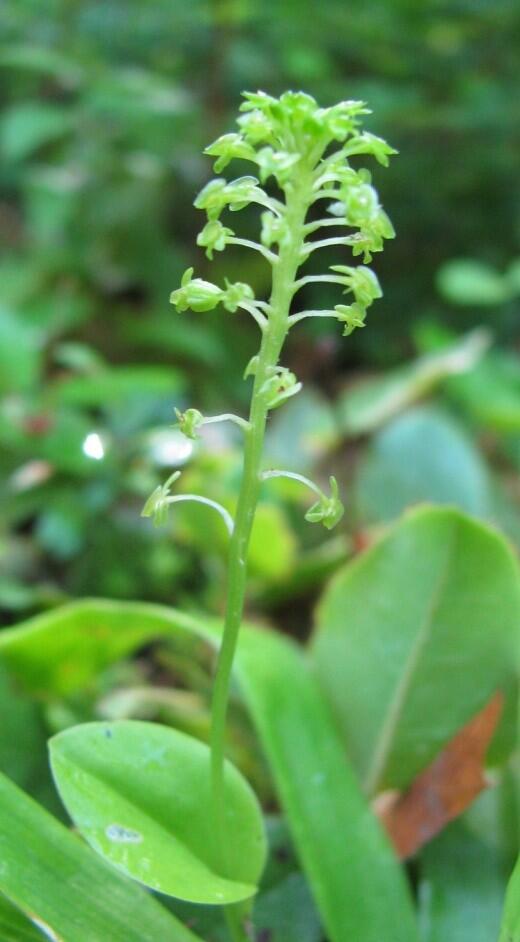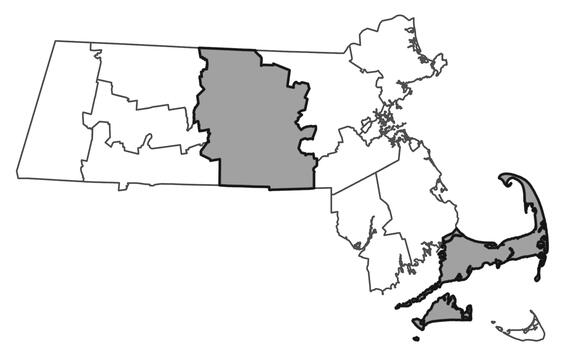- Scientific name: Malaxis bayardii
- Species of Greatest Conservation Need (MA State Wildlife Action Plan)
- Endangered (MA Endangered Species Act)
Description

Bayard’s Adder’s-mouth (Malaxis bayardii)
Bayard’s adder’s-mouth is a globally rare, pale green orchid (family Orchidaceae) of dry open woodlands, pine barrens, and similar habitats. Reaching only 9-26 cm (3.5-10.2 in) in height, this delicate orchid has a cylindrical raceme of up to 70 tiny chartreuse flowers, and typically one bright green stem leaf.
The leaf (or leaves, as occasionally there are two) of Bayard’s adder’s-mouth is ovate to elliptic in shape, and up to 3.8 cm (~1.5 in) in length; at its base, it clasps and sheaths the stem. The leaf sheath and stem have 5 to 8 lengthwise ridges. The raceme, 2-12 cm (4.7 in) in length, bears tiny flowers (3-4 mm wide; 0.12-0.16 in) on short pedicels (3.4-5 mm; 0.13-0.2 in). The flowers are bilaterally symmetric, with two linear, sickle-shaped petals, and a broadly rhomboid-deltoid lip. The lip has two lobes (auricles) at the base, and three at the apex; the center apex lobe is smaller than the lateral lobes. The sepals are oblong and elliptic with involute margins. Floral bracts are small and triangular. The fruits are capsules and are nearly spherical to egg-shaped.
Bayard’s adder’s-mouth can be differentiated from green adder’s-mouth (Malaxis unifolia, threatened), a very similar species, through examination of the flower, inflorescence, and habitat characteristics. The flowers of green adder’s-mouth have auricles (base lobes) that are less than 0.6 times as long as the distance between the base of the lip and the tip of the middle apex lobe, whereas the auricles of Bayard’s adder’s-mouth is 0.6 times or greater than this distance. Flowers of green adder’s-mouth have longer pedicels (5-10 mm; 0.2-0.4 in), are more densely arranged at the top of the raceme, and wilt more quickly at the base of the inflorescence, than those of Bayard’s adder’s-mouth. Further, green adder’s-mouth occupies wet or moist habitats, whereas Bayard’s adder’s-mouth is known primarily from dry sites.
Life cycle and behavior
Bayard’s adder’s-mouth flowers midsummer and produces fruits mid- to late summer.

Population status
Bayard’s adder’s-mouth is listed under the Massachusetts Endangered Species Act as endangered. All listed species are legally protected from killing, collection, possession, or sale, and from activities that would destroy habitat and thus directly or indirectly cause mortality or disrupt critical behaviors. The Massachusetts Natural Heritage & Endangered Species Program has 6 records from 4 counties: Barnstable, Dukes, Essex, and Worcester. Five of these records have been observed within the last 25 years.

Distribution in Massachusetts. 1999-2024. Based on records in the Natural Heritage Database.
Distribution and abundance
Bayard’s adder’s-mouth is currently or historically known from eleven states from Vermont, New York, and Massachusetts, south to North Carolina and west to Ohio (though it is apparently absent from Maryland and Delaware).
Habitat
Bayard’s adder’s-mouth inhabits open to partially shaded sites of disturbance-dependent habitats, such as grassland sand plains, pine barrens, pitch pine–scrub oak barrens, and dry open woodland edges; the substrate is dry sandy or clay soil. Optimal cover consists of a mix of native grasses, low herbs, and patchy shrubs; associated species include little blue-stem (Schizachyrium scoparium), poverty-grass (Danthonia spicata), yellow wild indigo (Baptisia tinctoria), showy aster (Eurybia spectabilis), trailing arbutus (Epigaea repens), wintergreen (Gaultheria procumbens), bearberry (Arctostaphylos uva-ursi), hair-cap moss (Polytrichum commune), bracken fern (Pteridium aquilinum), pitch pine (Pinus rigida), and oaks (Quercus spp.).
Healthy habitats are vital for supporting native wildlife and plants. Explore habitats and learn about conservation and restoration in Massachusetts.
Threats
The open, disturbance-dependent habitats occupied by Bayard’s adder’s-mouth are subjected to a variety of threats. Exclusion of natural disturbance or a lack of active management, and the resulting habitat succession to dense woody vegetation or a closed-canopy situation poses a threat to the species in Massachusetts, probably at each current location to some extent. Competition from aggressive native or invasive herbs or shrubs, or over-shading from taller woody plants may suppress the plant, keeping it from flowering, or triggering dormancy. Exotic plants known to invade dry, disturbed habitats, such as knapweeds (Centaurea spp.) and spurges (Euphorbia spp.), are capable of dominating vegetation cover once they become established. Additional threats include destructive habitat disturbance that damages or kills plants, or compacts or disrupts soil, such as road maintenance or ORV use; land conversion for development or other anthropogenic land uses; and inappropriate management, such as mowing during the reproductive period.
Conservation
As with all species, maintaining habitat quality is essential Bayard’s adder’s-mouth habitat should be monitored for competition and over-shading by aggressive native and exotic invasive plants. If natural succession results in over-shading of the rare orchid habitat, or exotic plants become established, a vegetation management plan should be constructed. Management strategies may include mowing (outside of the orchid’s growing season), tree removal, prescribed burning, or targeted invasive plant removal. Population locations that receive heavy recreational use (e.g., hiking, ORV) should be carefully monitored for plant damage or soil disturbance; trails can sometimes be re-routed to protect the rare plant population. All active management within the habitat of a state-listed plant (including invasive species removal) is subject to review under the Massachusetts Endangerd Species Act and should be planned in close consultation with the MassWildlife’s Natural Heritage & Endangered Species Program.
References
Meyer, F.G. 1997. Magnolia. In: Flora of North America Editorial Committee, eds. 1993. Flora of North America North of Mexico. 15+ vols. New York and Oxford. Vol.3, p 8.
Rhoads, A. F., and T. A. Block. 2000. The Plants of Pennsylvania: an illustrated manual. University of Pennsylvania Press, Philadelphia, PA.
Contact
| Date published: | May 8, 2025 |
|---|